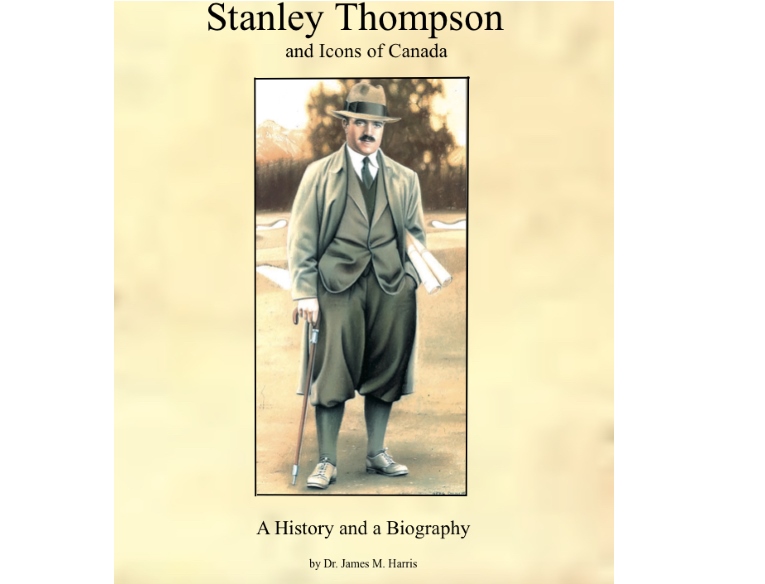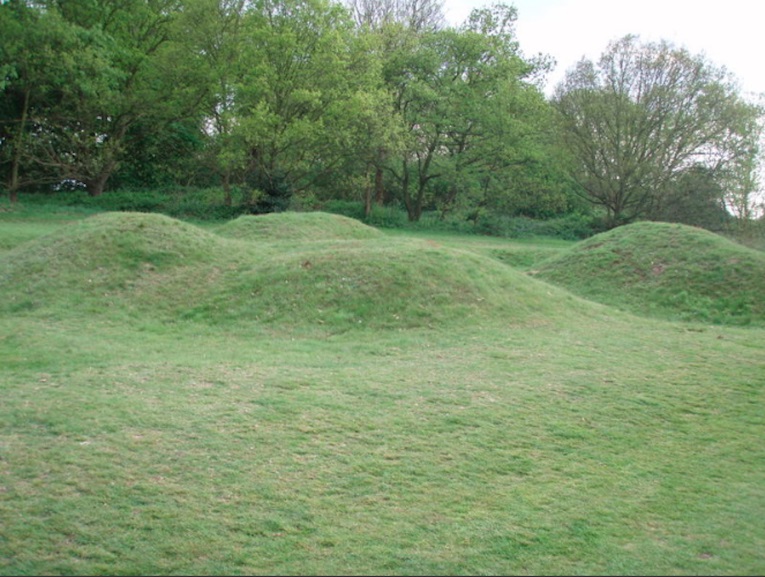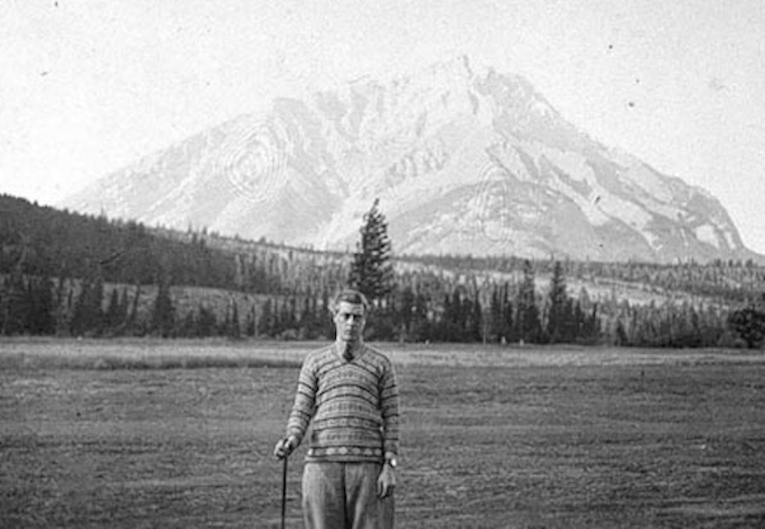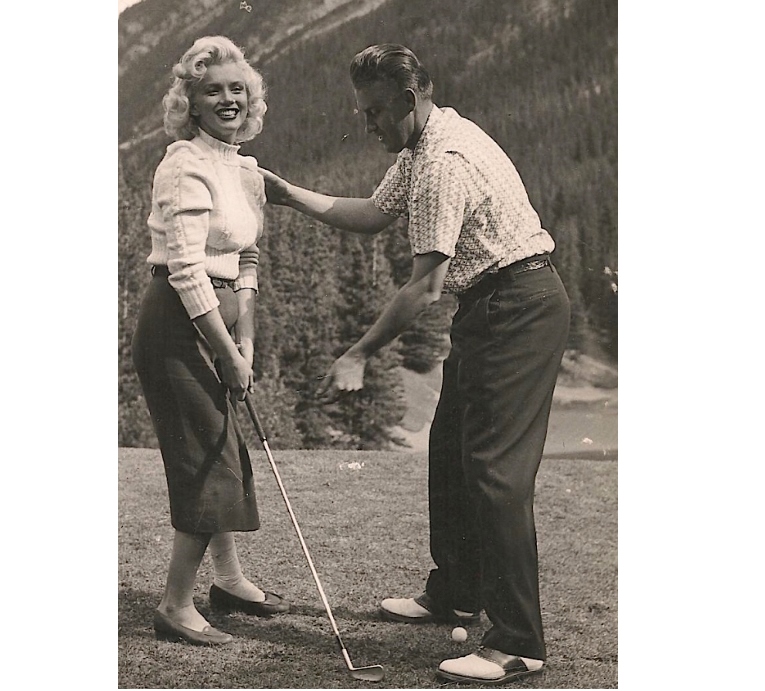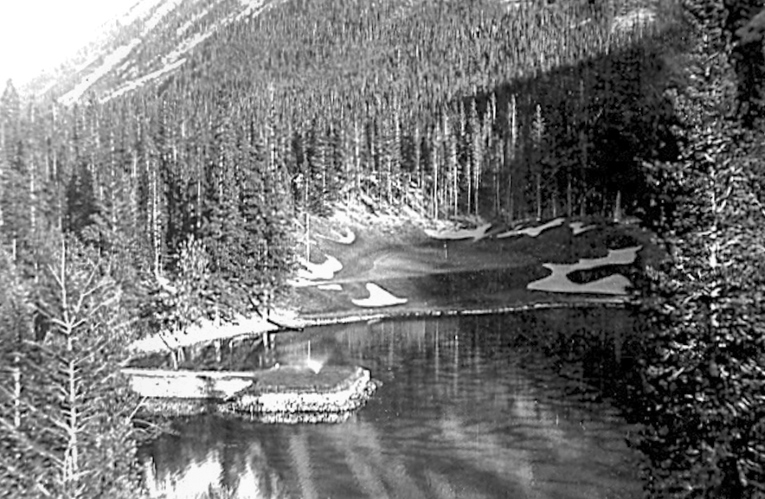Feature Interview with Dr. James Harris
October, 2018
Dr. Harris comes from the tradition of a golfing family passed on to him by his father who immigrated to Canada from Montrose, Scotland. He first got a degree in history from the University of Saskatchewan, then changed direction and graduated with an MD in 1980. He is currently a family doctor in Prince Albert SK, an active golfer, and a member of the Board of The Stanley Thompson Society. His book Stanley Thompson and the Icons of Canada was released in August, 2018 and may be purchased through the Stanley Thompson Society and its web site www.stanleythompson.com.
1. What made you write Stanley Thompson and the Icons of Canada? What did you hope to accomplish?
The short answer is that a few years ago Stanley’s great-nephew Bill Newton told me that he thought a new biography of Stanley Thompson was needed. I agreed, and as it has been said, if you can’t find what you want to read, write it yourself.
The longer answer is that over the past ten to fifteen years I have developed a deeper appreciation of Golden Age golf architects and their courses. Actually, my increased awareness dates to May 1981 when I played a course that was designed in 1925 by Wilfrid Reid called Indianwood GC in Lake Orion, MI. It had been abandoned and untouched for 20 years or more and it was just starting to be revived in 1981. The experience of playing a raw, unspoiled, vintage Golden Age champion-ship caliber golf course left me with an indelible memory.
Years later I wrote histories for my local home courses (Cooke Municipal GC which was a one-only 1925 design by Hubert Cooke and Stanley’s Waskesiu GC). That led me to The Stanley Thompson Society and ultimately to this book.
What I hope to accomplish is to help reaffirm Stanley Thompson’s position in the top echelon of Golden Age architects. He sometimes gets overshadowed by the contemporary greats who worked in the United States. A secondary goal is to show how Stanley Thompson is linked to events of significance in the history of early modern Canada.
2. What/where proved to be your best sources for material?
Without question it was primary source material collected by John Smith who was the archivist of the Stanley Thompson Society. Mr Smith passed away in July 2018. Beyond that, The National Archives in Ottawa ON had valuable information on the National Park courses. Records of debates in Canada’s House of Commons and the diaries of Prime Minister Mackenzie King were also useful. Valuable information was provided by Robert Trent Jones’ biographer Jim Hansen.
Overall however, I think it is fair to say that I had to search far and wide and gather material a little bit at a time from a wide variety of sources. Having Stanley’s surviving relatives confirm or explain some source material was also very helpful.
3. What surprised you the most throughout the undertaking?
The biggest surprise was how many important individuals and events from Canada’s history tie into the stories of Stanley’s courses. I set out to write a story about Stanley the golf architect but found that to provide meaningful context I had to integrate some Canadian history which I think results in a richer more interesting story. Along the way I learned a lot and my hope is that readers will likewise learn.
If I could add one more thing, I was surprised by the high regard that Sleepy Hollow GC in Brecksville OH that was built by Stanley in 1925 is held. (A course on my yet-to-play list.)
4. As a history lesson for us, please expand upon your sentence: ‘It would be difficult if not impossible to overstate how much CPR was hated in the 1920s prairie west.’
The answer goes back to the earliest days of Canada’s history. Canada was confederated by men from Eastern Canada whose main motivation was to prevent the country from becoming part of the United States. In order to establish Canadian sovereignty in the West, a trans-continental railway was needed and the government engaged a small syndicate of entrepreneurs who called themselves the Canadian Pacific Railway to build it. In return, the Government supported the syndicate with loans and gave them ownership of about 45% of all arable land in the future Saskatchewan and Alberta and parts of Manitoba and British Columbia.
Forty years later the 1920s prairie west was now populated and the CPR had become a powerful corporation. The CPR was not only a major landowner but they also controlled the shipping of grain which was the mainstay of income for prairie farmers. The CPR was a hard-nosed corporation that monopolized many aspects of the lives of prairie farmers and the farmers resented it. This is a somewhat simplistic explanation, but I think it paints the picture.
5. It seems especially accurate to say that Thompson was a product of his environment. By that I mean, the gorgeousness of his home country, its expansiveness tied together by rail in his life, and the National Parks Act of 1930 all contributed to some of his corner-stone designs. Thoughts?
In many ways it is true that Stanley Thompson was in the right place at the right time. Golf boomed in the 1920s and that allowed him to express what I believe to be his innate design genius. However, as you suggest, when that genius was combined with exquisite properties and the virtually unlimited financial backing of the British Properties Co. (Capilano), the CNR (Jasper), the CPR (Banff, St. George’s) and the National Parks Branch of the Government of Canada (Highlands Links), great cornerstone designs across the expanse of Canada were the result.
6. Tell us about Thompson in World War I and how he was introduced to plasticine.
Stanley was a signaller attached to an artillery unit from January 1915 until November 1918. At that time Canada was still a colony of Great Britain but Canada took a giant stride toward independence when for the first time exclusively Canadian forces fighting as a single unit won the Battle of Vimy Ridge in 1917. The Canadian commander was Arthur Currie and he used plasticine to construct elaborate models of the German trenches and positions to brief the men before the battle. After the war Stanley incorporated the technique of modelling landscape in plasticine into golf course design (as did fellow Canadian A. V. Macan who was also at Vimy Ridge).
As a personal note, during the writing of this book my daughter worked as a tour guide at Vimy Ridge and we visited her in France. That visit gave me a greater understanding of the horrors and the pointless slaughter of trench warfare in World War I. Also, during the time I was writing this book a statue of Sir Arthur Currie was unveiled in his hometown of Strathroy ON and the Vimy Ridge Memorial has now be-come the image on the back of Canada’s twenty dollar bill.
7. He explored England during and after the War. The picture of the Alpinization or mounding that you show from Royal Mid-Surrey sure looks straight off a Thompson course. Safe to say that is where he was first exposed to such?
Part of the thesis of my book is that in 1915 or 1916 Stanley was influenced by seeing the work of J. H. Taylor and his innovative use of moving earth to create mounds, bunkers, and other land forms at Royal Mid-Surrey. Charles Blair Macdonald (who was born in Canada by the way) and A. W. Tillinghast were other Golden Age golf architects who introduced landscape architecture into golf course design in North America.
8. What prompted him to become an architect after the War?
Stanley and his brothers had grown up caddying at the Toronto GC (H.S.Colt, 1913) and it was there that they caught the golf bug. The Toronto GC professional was George Cumming who was also an early Canadian golf architect.
When Stanley returned from WWI he found that George Cumming and Stanley’s older brother Nicol, pro at Hamilton G&CC, (H. S. Colt, 1914) were starting a golf design business. Stanley was said to have had some skill in landscape gardening, so it was a natural for him to join the firm. Thompson, Cumming, Thompson lasted only about one year leaving Stanley to go solo but his career took off soon thereafter.
9. What were a couple of his early significant works?
By early I take that to mean pre-Jasper. Because 1922 and 1923 were such prolific years for Stanley this is a tough one. I am going to give you four. The first would be the remaking of Mississauga G&CC (Toronto ON) in late 1921. This great course has since hosted the Canadian Open six times. The second is Muskoka Lakes G&CC included because it was Stanley’s first solo design. The third is Niakwa CC (Winnipeg MB) done in 1923. This course hosted the Canadian Open in 1961 and is included because it finds Stanley beginning to embrace working far away from his Toronto home. Finally, I would include Thornhill G&CC (Toronto ON) from 1923 because it is a personal favourite and Thornhill is where Byron Nelson won the Canadian Open as #11 of his record 11 straight PGA tour wins in 1945.
10. One of his partners said that Thompson changed in the early 1920s just as the Roaring 20s were kicking into gear. He became a great spender and liked to travel first class and wine and dine. Would you agree that his expansive personality was reflected in his flamboyant architecture? Your quote from Daniel Burnham of ‘Make no little plans’ perfectly sums up Thompson!
Yes, I would agree. I think that Stanley, like many other men, was forever changed by the horrors of WWI. After the war he adopted the pervasive 1920s attitude that people should enjoy themselves while they can, an attitude that is probably best reflected in F. Scott Fitzgerald’s The Great Gatsby. I also believe that some of that attitude was rubbed off on Stanley by Sir Henry Thornton who was his patron when they got together in 1923. Stanley was somewhat shy at his core and not quite like the ultimate hedonists of fiction but doubtless he fully enjoyed the best of food, drink, clothing, travel, and lodging. My view of him is as a genius and an artist whose expansive vision could indeed blossom into flamboyant architecture to borrow your phrase.
11. Of his Big Five (Jasper, Banff, St. George’s, Capilano and Cape Breton Highland), Jasper came first and as you write, ‘The golf course at Jasper made Stanley immediately famous around the world.’ The year was 1923 and crucial to Thompson’s success was Sir Henry Thornton – tell us about him and their relationship.
Sir Henry Thornton is an interesting man and key to the Stanley Thompson story. He was born in Indiana, attended the University of Pennsylvania where he played football and then became the coach of the Vanderbilt football team. He was a railroad man who rose to become the Superintendent of the Long Island Railroad. Thornton was then hired to become the General Manger of the Great Eastern Railway in England in 1914. Recognized as an organizational genius, he was put in charge of all rail transport to the front lines in France and Belgium in the later stages of World War I. His accomplishments earned him medals of distinction from a number of different countries. Thornton became enamored with Edwardian England and he gave up his United States citizenship and became a British citizen (and a member of Royal Mid-Surrey GC). He was made a Knight Commander of the British Empire after the war.
Meanwhile back in Canada, in the 15 or so years before 1923, a couple of new railways were built to try and challenge the monopoly of the CPR. They failed and the Government of Canada was left to take them over. Canada’s prime minister enticed Sir Henry to move to Canada to run the amalgamated mess of failed railways which was called the Canadian National Railway (CNR).
One of Thornton’s first moves with the CNR was to develop Jasper as a tourist resort and he engaged Stanley Thompson to build the golf course. Over several years Sir Henry Thornton was successful in turning the CNR around and making it a profitable enterprise. He continued to be a friend and a patron of Stanley Thompson and his golf design career.
Sir Henry’s success with the CNR was a direct competitive threat to the power of the CPR, and once the political party that was tied to the CPR took office, Sir Henry was subjected to intense hostile government committee questioning which caused him to resign in 1932.
Sir Henry Thornton was an American who became a British citizen and then spent the last years of his career in Canada. Despite his larger than life persona and his extensive accomplishments he is not well remembered in any of those three countries.
12. Tell us the circumstance that prompted Thompson to utter, ‘Gentlemen, you wouldn’t spoil a ship for a hap’orth of tar would you?’
The utterance is interesting because we’re not really sure if Stanley actually said it or if it is just part of the legend that has been constructed around him. Regardless, it fits. The utterance is Stanley appealing to the Canadian National Railway to provide extra money to complete the golf course at Jasper. He is appealing for a hap’orth (a relative half-penny worth) of more money to buy tar so that the construction of the ship (the golf course) is not spoiled. Sir Henry Thornton and the CNR board gave him all the funds he wanted at Jasper.
13. What did Alister MacKenzie think when he visited Jasper in 1928?
I don’t think it is an overstatement to use the vernacular and say that he was ‘blown away’. Dr. MacKenzie described Jasper as by far the best inland golf course in Canada or the United States (this would exclude his own Cypress Point). It is fascinating to read the full text of the detailed five page report that Dr. MacKenzie produced in 1928. Examples of his hole-by-hole analysis are; 2nd Hole “ This is one of the great holes in golf”, 4th Hole “ This is one of the most perfect holes of its length in existence”, 10th Hole “Magnificent”, 14th, 15th and 16th Holes “are magnificent”, 18th Hole “The best finish in the World of Golf”.
Something else Dr MacKenzie says in the report appeals to me; “One of the difficulties confronting most Golf Clubs is that the Course gets into the hands of well meaning but inexperienced committeemen who try to justify their existence by suggesting the addition of hazards and alterations designed from a penal point of view – as a consequence they often destroy the original strategic character of the holes.” He was confident that wouldn’t happen at Jasper.
One can’t help but conclude that seeing Jasper influenced Dr. MacKenzie when he began the design of Augusta National a short time later.
14. Banff came next. Your picture of the Prince of Wales in 1923 at Banff shows the course that Thompson overhauled to have been of little merit, correct?
Yes, I think that is correct. Although Donald Ross designed 9 of the original Banff 18, the resulting golf course was flat and featureless. With an unlimited budget from the CPR, Stanley was able to bring in trainloads of topsoil to sculpt mounds and bunkers and use judicious blasts of dynamite to cut into the surrounding mountains to create some very dramatic holes. Also, the completion of Stanley’s course coincided with the completion of the stone castle Banff Springs Hotel. Stanley’s golf course at Banff integrates the mountains and the hotel to create an experience that transcends any single one of those three elements.
15. You offer strong praise for St. George’s. Can we goad you into sharing with us your own personal view of his top 5? Is St. George’s at the top?
Knowing that no matter what I say I will be criticized, I will allow myself to be goaded. My personal list would be #1. Jasper #2. St. George’s #3. Highlands Links #4. Banff #5. Capilano.
Each of the five are great and not listing St. George’s first puts me at odds with most expert golf course rankers. But, there is just something about Jasper that makes me want to play it over and over again. I recently heard someone say that it is even more important that a golf course suits one’s heart than it suits one’s eye.
I would add that, after a lot of consideration, I think there is a huge tie for sixth place between ten or twenty of Stanley’s other designs.
16. Despite the stunning successes, Stanley Thompson & Co. was insolvent by 1932. How?!
There were a number of factors some of which were peculiar to Stanley and some which were beyond his control. As mentioned previously, Stanley spared no expense on personal indulgences. Further, he used some of his money to support his aging parents. Finally, through the 1920s Stanley often hired more than needed World War I veterans to help build his courses. However, on their own these things would not have caused insolvency.
Stanley had scored huge paydays from the railways (CNR and CPR) to build Jasper, Banff and St George’s. Based on this success and anticipating more, he hired a number of new associates and employees in 1930. What Stanley didn’t foresee was that conflict in Canada’s national politics would mean that the railways would never again build another golf course. Further, Sir Henry Thornton was ousted from the CNR and Stanley lost his patron.
The onset of the Great Depression combined with Canadian political wrangling meant that payment for work on a number of golf courses including Midvale, Carleton Island, Dundas Valley, Montebello and others was not forthcoming in whole or in part and further that the Capilano project would be delayed. Stanley was loathe to dismiss or lay-off any employees and while the expense meter continued to run, the flow of income slowed to a trickle. Insolvency was the result.
17. You label one section as ‘Stanley’s Triumph in Routing – Capilano GC, February 1932’. Beautifully worded – please elaborate.
Capilano GC is located on a mountain slope across Burrard Inlet which separates it from the city centre of Vancouver BC. The golf course moves down the slope some 300 to 400 feet and then back up again. The topography is not one that would ideally be chosen for a golf course. However, Stanley spent the better part of the month of February 1932 crafting a route on the land he was presented with. Apart from a couple of holes, the flow of the golf course renders the elevation change to be almost imperceptible. The result is a great golf course – one of Stanley’s best. A number of golf architects including Tom Doak cite Capilano as one of the best routings ever in the history of golf architecture.
18. Cape Breton Highlands came last in 1939. Tell us about its construction process.
The construction of Highlands Links GC was the result of the government of Canada attempting to stimulate the economy by establishing national parks in Atlantic Canada to promote tourism. A national park was established on the East coast of Cape Breton Island and at that time a golf course was considered essential to attract tourists. Stanley was the architect of choice for the national parks.
Stanley is said to have believed that golf architects should use nature as their guide. Highlands Links GC is an example of where that is the case. Stanley followed his muse to route a course that winds it way from the ocean, through low mountains, the Clyburn River and scenic forested valleys resulting in not only stunningly great golf but stunningly great vistas.
Highlands Links was built by the manual labour of hundreds of Cape Bretoners and the naturally occurring slopes and hillocks were left mostly in place. Supervising construction were Stanley’s best associates including C. E. (Robbie) Robinson, Geoffrey Cornish, and engineer Hennie Henderson. Stanley also engaged Ken Gullan from Scotland expressly to help give the course a Scottish look and feel. Construction started in 1939 and was finished by August 1940.
Cape Breton is a destination which allows people to get as close as they can to experiencing Scotland while still being in North America. Highlands Links GC on the east coast is now joined by the great new courses Cabot Links and Cabot Cliffs on the west coast of Cape Breton Island.
19. Your final tally is that he made plans for 147 courses, of which 121 were built and 26 no longer exist. Which of those 26 do you most lament the passing of?
I think it would be St. Andrews GC in Toronto. It was built on favourable land in Toronto’s York Mills area in 1926. The Canadian Open was played there in 1936 and 1937 and the course stood up well. St. An-drew’s was lost to urban sprawl and freeway development in the early 1950s. There has been relatively little known about St. Andrews GC but recently Canadian based golf course architect Jeff Mingay has obtained the blueprint plans and he has developed some information about the course.
20. Which of the 121 do you think would most benefit from a proper restoration?
I am going to somewhat dodge this question. First, I haven’t played every Stanley Thompson course and second I am reluctant to comment on a course where I am not a member. What I will say is that I would love to see the second nine holes at Fundy Bay GC be built and the course at Waterton Lakes be restored to Stanley’s 1950 vision. Both of these are National Park courses so as a Canadian citizen I am technically a member at both places.
21. Tell us about Robert Trent Jones and his relationship with Thompson. I was particularly surprised to learn of Jones’s input re: The Devil’s Cauldron!
To address the second part first, Jones was sent West by Stanley in the summer of 1932 to do an inspection report on Banff. In letters back to his fiancee, Jones was clearly smitten with Banff; “ … This mountain country makes me feel very romantic, dearest. What a Don Juan I could be if you were here”, he writes. In his report on the golf course he especially focused on The Devil’s Cauldron and its bunkering. The bunkering sketch he made can be found on page 47 of James Hansen’s A Difficult Par.
I like to describe the relationship between Stanley Thompson and Robert Trent Jones as one of an unspoken but mutually agreed to duplicity. The duplicity was somewhat forced on each man by the cruel reality of the Great Depression. Early on, Jones met Stanley when Jones was obliged to have an established architect supervise his work at Midvale GC. There was a meeting of design minds and Stanley took on Jones as a partner seemingly to give him an entree into work in the United States. Soon thereafter, lacking any work that paid, each was asking to borrow $50 from the other (which neither had) in 1931 and 1932.
After 1932 Stanley did some of work on his own in Canada and Jones did some work on his own in the United States. Gradually, Jones came to understand that he could have a career without Stanley. Their partnership ended in effect when Stanley found work in Brazil and Jones declined to come and join him. As a last act, Jones published a brochure in 1938 wherein it was implied that he had a major role in courses done by Stanley before they were partners. Despite this appropriation of reputation, the two remained friends and both were later founding members of the American Society of Golf Course Architects in 1948.
22. What is Thompson’s lasting legacy?
The first part of the answer is simply every golf course he designed which Robert Trent Jones said were “always good”.
The second part of the answer is his role in working across the expanse of the nation to enhance so many of Canada’s iconic locations.
Finally, I would also add his important role in establishing that golf course architecture deserved to be recognized as a profession in its own right.


